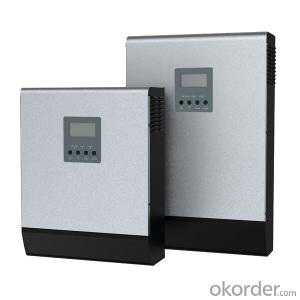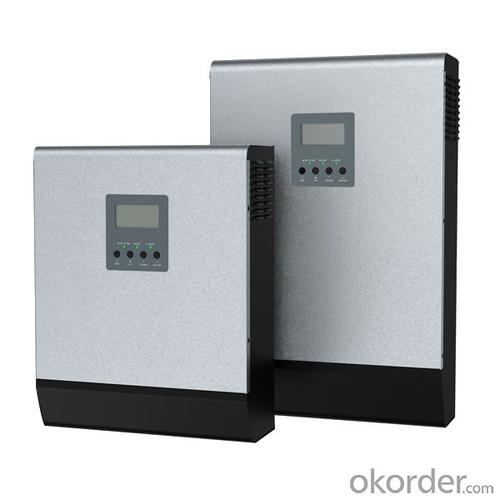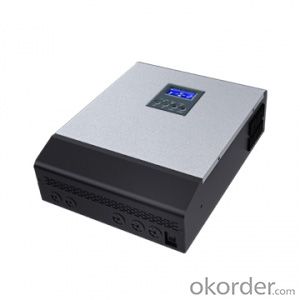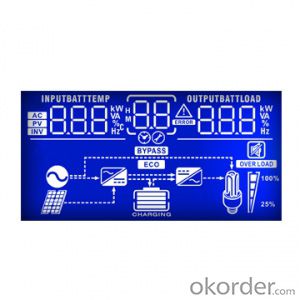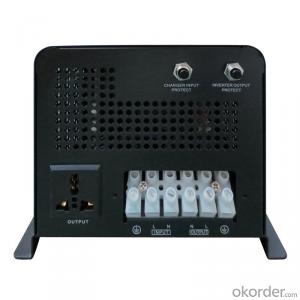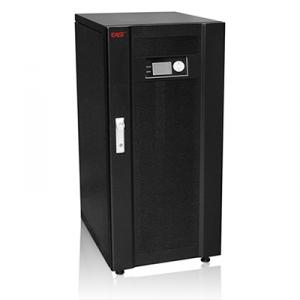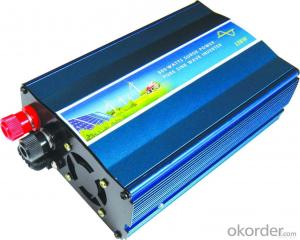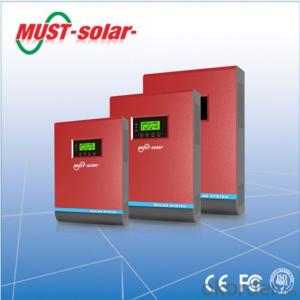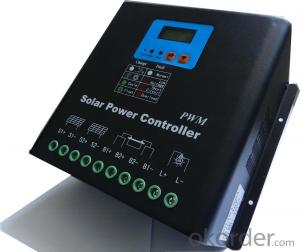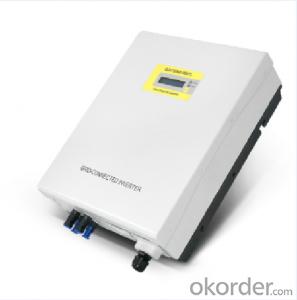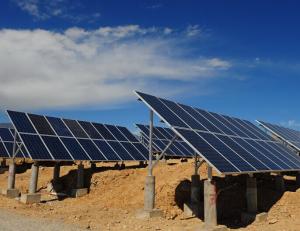Solar Inverter PV1800 5KVA Off-grid With Parallel Operation Low Frequency
- Loading Port:
- China main port
- Payment Terms:
- TT or LC
- Min Order Qty:
- 50 unit
- Supply Capability:
- 1000 unit/month
OKorder Service Pledge
OKorder Financial Service
You Might Also Like
Features:
. Pure sine wave inverter
. Selectable input voltage range for home appliances and personal computers
. Selectable charging current based on applications
. Configurable AC/Solar input priority via LCD setting
. Compatible to mains voltage or generator power
. Parallel operation with up to 4 units only available for PV200 4KVA/5KVA
. Auto restart while AC is recovering
. Overload and short circuit protection
. Smart battery charger design for optimized battery performance
. Cold start function
PV1800 5KVA, Off-grid solar and utility inverter with parallel operation.
Model | PV1800-1KVA | PV1800-2KVA | PV1800-3KVA | PV1800-4KVA | PV1800-5KVA |
RATED POWER | 1000VA / 800W | 2000VA/ | 3000VA / 2400W | 4000VA / 3200W | 5000VA / 4000W |
INPUT | |||||
Voltage | 230 VAC | ||||
Selectable Voltage Range | 170-280 VAC (For Personal Computers) ; 90-280 VAC (For Home Appliances) | ||||
Frequency Range | 50 Hz/60 Hz (Auto sensing) | ||||
OUTPUT | |||||
AC Voltage Regulation | 230 VAC ± 5% | ||||
Surge Power | 2000VA | 4000VA | 6000VA | 8000VA | 10000VA |
Efficiency (Peak) | 90% | 93% | |||
Transfer Time | 10 ms (For Personal Computers) ; 20 ms (For Home Appliances) | ||||
Waveform | Pure sine wave | ||||
BATTERY | |||||
Battery Voltage | 12 VDC | 24 VDC | 48 VDC | ||
Floating Charge Voltage | 13.5 VDC | 27 VDC | 54 VDC | ||
Overcharge Protection | 15 VDC | 30 VDC | 60 VDC | ||
Maximum Charge Current | 10 A or 20 A | 20 A or 30 A | 20 A or 30 A | ||
SOLAR CHARGER (OPTION) | |||||
Charging Current | 50 A | ||||
Maximum PV Array Open Circuit Voltage | 30 VDC | 60 VDC | 90 VDC | ||
Standby power Consumption | 1 W | 2 W | 2 W | ||
PHYSICAL | |||||
Dimension, D x W x H (mm) | 95 x 240 x 316 | 100 x 272 x 355 | 120 x 295 x 468 | ||
Net Weight (kgs) | 5.0 | 6.4 | 6.9 | 9.8 | 9.8 |
OPERATING ENVIRONMENT | |||||
Humidity | 5% to 95% Relative Humidity(Non-condensing) | ||||
Operating Temperature | 0°C - 55°C | ||||
Storage Temperature | -15°C - 60°C | ||||
Images
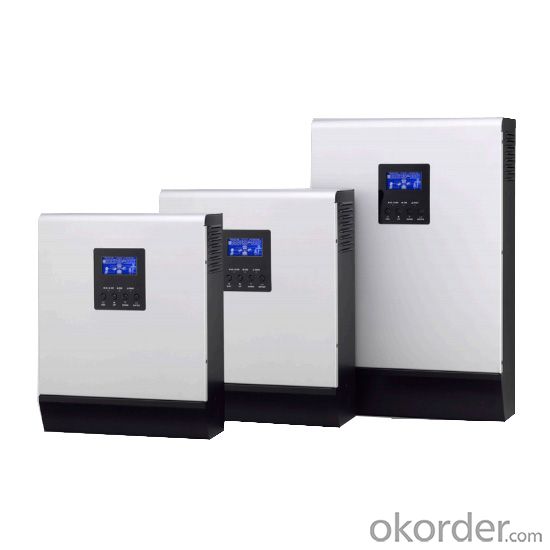
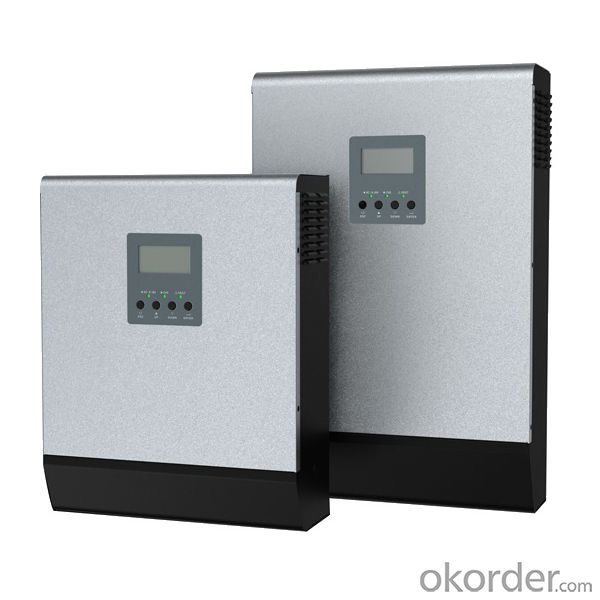
Warranty
provides a 1~3 year limited warranty (“Warranty”) against defects in materials and workmanship for its Uninterruptible power supply, Power inverter/chargers, Solar charge controllers, Battery Products (“Product”).
The term of this Warranty begins on the Product(s) initial purchase date, or the date of receipt of the Product(s) by the end user, whichever is later. This must be indicated on the invoice, bill of sale, and/or warranty registration card submitted to MUST-Solar. This Warranty applies to the original MUST-Solar Product purchaser, and is transferable only if the Product remains installed in the original use location.
FAQ
1.How do I decide which system is right for me ?
For protection from long outages, include a generator or solar panels in your Must solar system. Shorter outages can be handled by a battery-only system.
2. Where my system will be installed ?
Must solar systems are usually wall-mounted near a home's main electrical (circuit breaker) panel.
3. How do I install my system ?
A must solar backup inverter is connected to a home electric system , we will supply detailed installation manual and videos for our customers .
- Q: How does a solar inverter affect the overall system cost?
- A solar inverter affects the overall system cost by adding to the initial investment required for installing a solar power system. Inverters are an essential component in converting the DC electricity produced by solar panels into usable AC electricity for our homes or businesses. The cost of a solar inverter depends on its capacity, brand, and features. While inverters do add to the overall system cost, they are crucial for efficient energy production and can enhance the system's performance and longevity.
- Q: How does the input current rating affect the performance of a solar inverter?
- The input current rating of a solar inverter directly affects its performance as it determines the maximum amount of current that the inverter can handle from the solar panels. If the input current rating is too low, it may not be able to handle the full power output of the solar panels, leading to inefficiency and potential damage to the inverter. On the other hand, if the input current rating is too high, it may be overkill for the system, resulting in unnecessary costs. Therefore, selecting an appropriate input current rating is crucial for optimal performance and longevity of a solar inverter.
- Q: What are the safety certifications to look for in a solar inverter?
- When looking for safety certifications in a solar inverter, some important ones to consider include the UL 1741 certification, which ensures compliance with safety standards for grid-connected inverters, and the IEC 62109 certification, which verifies the safety of the inverter in regards to electrical and fire hazards. Additionally, certifications such as CE, TÜV, and ETL mark can also indicate compliance with safety standards and regulations.
- Q: How does a solar inverter affect the overall aesthetics of a solar installation?
- A solar inverter does not directly impact the aesthetics of a solar installation as it is typically installed indoors or in an inconspicuous location. However, a well-designed solar inverter system can contribute to a cleaner and more organized appearance of the overall solar installation by reducing the need for visible wiring and ensuring efficient energy conversion.
- Q: Three-phase photovoltaic inverter grid, the use of phase-locked loop is what?
- Photovoltaic inverters for grid-connected photovoltaic power generation systems are primarily capable of receiving DC power from photovoltaic arrays and converting them into sine-wave currents of the same frequency and in phase with the access grid for powering the grid or local loads.
- Q: What is the maximum number of solar panels that a solar inverter can support?
- The maximum number of solar panels that a solar inverter can support depends on the capacity and specifications of the specific inverter model. There is no universal limit, as different inverters have different capabilities, but typically, a solar inverter can support anywhere from a few panels to several hundred panels. It is important to consult the manufacturer's guidelines and technical specifications to determine the maximum number of panels that a particular solar inverter can handle.
- Q: What are the key factors affecting the installation process of a solar inverter?
- The key factors affecting the installation process of a solar inverter include the site location and orientation, electrical wiring and connections, proper grounding, adequate ventilation and cooling, and compliance with local regulations and safety standards. Additionally, the choice of mounting structure, the proximity to the solar panels, and the availability of a reliable power supply are also important factors to consider during the installation process.
- Q: How does a solar inverter handle high temperatures?
- A solar inverter handles high temperatures by incorporating various cooling mechanisms such as heat sinks, fans, and thermal management systems. These components help dissipate heat generated during the inverter's operation, preventing overheating and ensuring optimal performance even in hot climates.
- Q: Can a solar inverter be used with a solar-powered waste management system?
- Yes, a solar inverter can be used with a solar-powered waste management system. A solar inverter is used to convert the direct current (DC) electricity generated by solar panels into alternating current (AC) electricity that can be used to power various appliances and systems. In the case of a solar-powered waste management system, the solar inverter would be an essential component to convert the DC power generated by the solar panels into the AC power required to operate the waste management equipment.
- Q: Can a solar inverter be used in areas with high electromagnetic radiation?
- Indeed, a solar inverter is suitable for use in regions with abundant electromagnetic radiation. Nonetheless, it is crucial to acknowledge that the inverter's performance and reliability could potentially be impacted by the presence of such radiation. The existence of elevated radiation levels has the potential to induce electromagnetic interference (EMI), thereby causing disruptions in the inverter's operation and leading to decreased efficiency or even complete failure. Consequently, it is highly recommended to adopt necessary precautions, including implementing proper grounding and shielding techniques, as well as selecting inverters equipped with robust EMI protection mechanisms when installing solar inverters in areas with high electromagnetic radiation. Furthermore, seeking guidance from experts or manufacturers who possess knowledge regarding specific solar inverter models designed to endure and excel in environments characterized by high electromagnetic radiation is strongly advised.
Send your message to us
Solar Inverter PV1800 5KVA Off-grid With Parallel Operation Low Frequency
- Loading Port:
- China main port
- Payment Terms:
- TT or LC
- Min Order Qty:
- 50 unit
- Supply Capability:
- 1000 unit/month
OKorder Service Pledge
OKorder Financial Service
Similar products
Hot products
Hot Searches
Related keywords
